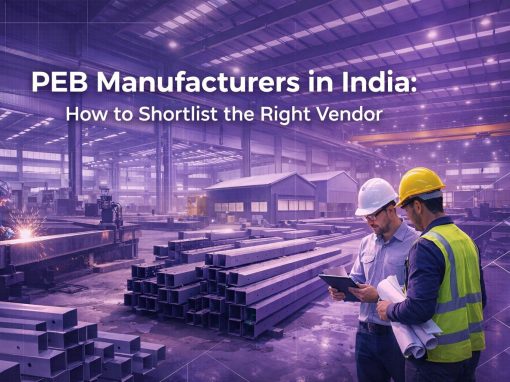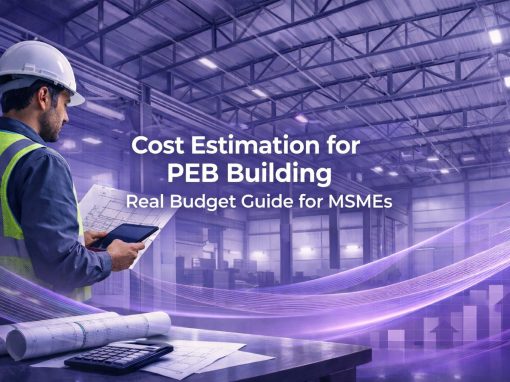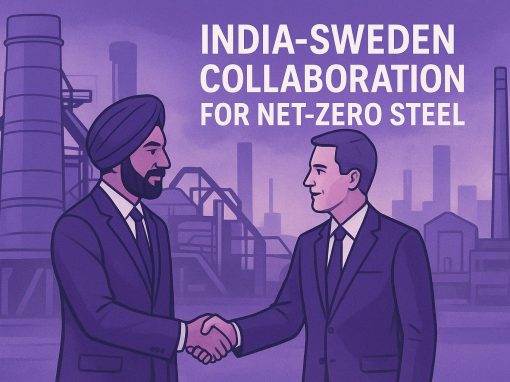Table of Contents
Steel procurement is a critical function for Micro, Small, and Medium Enterprises (MSMEs) in India, which contribute around 30% to the nation’s Gross Value Added (GVA) and nearly 46% of exports. These enterprises are key drivers of manufacturing and infrastructure, supporting economic growth and employment.
In 2025, the Indian steel market faces price fluctuations, with Hot Rolled Coil (HRC) steel trading around $800–815 per tonne, influenced by raw material costs, government regulations, and global trade policies. Domestic steel mills also grapple with metallurgical coke shortages, affecting production capacities.
Efficient steel procurement ensures MSMEs manage costs, maintain quality, and meet delivery timelines. Yet, challenges such as price volatility, supply chain disruptions, and regulatory compliance make sourcing steel a complex task for many small businesses.
Understanding Steel Procurement vs. Purchasing
In the context of steel, procurement refers to a strategic process that involves planning, supplier evaluation, contract negotiation, and managing the end-to-end acquisition of steel for business needs. It focuses on long-term value, cost efficiency, risk mitigation, and building reliable supplier relationships.
Purchasing, on the other hand, is more operational. It involves the transactional aspects of buying steel, such as placing orders, making payments, and ensuring timely delivery. While important, purchasing is narrower in scope and primarily addresses immediate requirements rather than long-term strategy.
| Aspect | Steel Procurement | Steel Purchasing |
| Definition | Strategic planning, supplier evaluation, contract management | Transactional process of buying steel |
| Scope | End-to-end sourcing lifecycle | Ordering and payment only |
| Objective | Long-term cost efficiency and supplier relationships | Fulfill immediate steel requirements |
| Focus | Risk management, quality, compliance | Price, quantity, delivery |
For MSMEs in India, adopting a strategic steel procurement approach is critical. It enhances operational efficiency, reduces risks from supply chain disruptions, and ensures access to consistent, high-quality steel. Over time, it also strengthens supplier partnerships, providing stability in a market prone to price fluctuations and regulatory changes.
Objectives of Steel Procurement
- Cost Management: Secure competitive steel prices to control budgets and maintain profitability, especially amid 2025 price fluctuations.
- Quality Assurance: Ensure correct steel grades for manufacturing or construction, preventing production delays and maintaining product standards.
- Supplier Relationships: Build long-term partnerships with reliable vendors for timely deliveries, consistent quality, and market support.
- Compliance: Adhere to BIS standards, GST regulations, and MSME-friendly tenders to avoid legal issues and access cost-effective procurement opportunities.
- Sustainability: Source recycled or eco-friendly steel to meet environmental responsibilities and promote sustainable business practices.
- Risk Management: Mitigate supply chain disruptions, price volatility, and shortages through strategic planning and diversified supplier networks.
- Case Example: A mid-sized Mumbai fabrication company reduced costs by 12% and avoided project delays by sourcing strategically from multiple verified suppliers, demonstrating the tangible benefits of structured steel procurement.
7 Stages of Steel Procurement for Businesses
Steel procurement is a structured process that helps MSMEs secure the right materials at the best price, while ensuring quality and timely delivery. Following a systematic approach reduces risks, improves supplier relationships, and optimises operational efficiency. Below is a breakdown of the seven key stages of steel procurement, with practical guidance for MSMEs in India in 2025.
Identifying Requirements
The first step in steel procurement is to clearly identify your business’s needs. This involves determining the correct steel grade, quantity, and specifications required for manufacturing or construction projects. Collaborating with engineers, project managers, and production teams ensures that all requirements are captured accurately. Clear documentation prevents over-ordering or under-ordering, which can lead to excess costs or project delays. For MSMEs, this stage lays the foundation for cost-effective and efficient procurement.
Market Research
Once requirements are clear, MSMEs must study the steel market. This includes tracking domestic price trends, monitoring import/export policies, and understanding factors that influence supply and demand. Comparing multiple suppliers and alternative sources helps identify the most cost-effective options. Market research may involve consulting industry reports, online platforms, government tender portals, or trade associations. By basing decisions on data, businesses can plan purchases strategically, taking advantage of favourable pricing periods and avoiding overpaying during market volatility.
Supplier Identification and Shortlisting
Not all suppliers meet the quality and reliability standards MSMEs require. Supplier identification involves evaluating potential vendors based on product quality, certifications, financial stability, delivery capabilities, and compliance with regulations. Tools like Requests for Information (RFI), supplier audits, or site visits help gather detailed insights. After assessment, businesses create a shortlist of suppliers most capable of meeting their needs. This step is critical for mitigating risks, ensuring consistent supply, and building long-term partnerships.
Solicitation Process
In this stage, MSMEs formally request proposals or quotations from shortlisted suppliers. Common methods include:
- Request for Quotation (RFQ): For standard steel products with defined specifications.
- Request for Proposal (RFP): For customised steel requirements or complex projects.
- Tenders: Particularly for larger orders or government projects.
Clear communication of evaluation criteria, timelines, and project specifications ensures suppliers can provide accurate and comparable bids. A well-managed solicitation process promotes transparency and competitiveness.
Evaluation and Selection
After receiving proposals or quotations, MSMEs must evaluate them carefully. Key considerations include total cost of ownership (including taxes, transport, and storage), delivery timelines, quality standards, and regulatory compliance. Using scoring matrices or comparison charts helps make objective decisions. Involving key stakeholders adds transparency and ensures alignment with business goals. The goal is to select the supplier offering the best balance of price, quality, reliability, and compliance.
Contract Negotiation and Finalisation
Once a supplier is selected, negotiating and finalising the contract is essential. This stage involves defining pricing, payment terms, delivery schedules, quality standards, and penalties for delays or non-compliance. Legal considerations must be addressed, and all agreements documented in a binding contract. Clear contracts protect both parties, prevent disputes, and ensure that MSMEs have recourse in case of supplier failures. Effective negotiation can also secure favourable terms, discounts, or priority deliveries.
Contract Management and Review
The procurement process does not end with signing the contract. Active contract management involves monitoring supplier performance, addressing any deviations from agreed terms, and ensuring timely deliveries. Regular reviews help identify areas for improvement and inform future procurement cycles. For MSMEs, ongoing management strengthens supplier relationships, ensures consistent steel quality, and reduces operational risks. By reviewing performance, businesses can adapt procurement strategies to market changes and internal needs.
Steel Procurement Challenges and Solutions
| Challenge | Description | Solution | Example |
| Price Volatility & Budget Constraints | Steel prices in India have fluctuated in 2025, with Hot Rolled Coil (HRC) trading around $800–815 per tonne. Sudden spikes affect budgets and project costs. | Plan purchases based on market trends, negotiate bulk deals, and explore MSME-friendly government tenders. | A Pune-based MSME saved 10% by timing orders during stable price periods and using multiple suppliers. |
| Supplier Reliability & Capacity Issues | Delays, inconsistent quality, or capacity shortages can disrupt production schedules. | Maintain a list of verified backup suppliers and assess supplier performance regularly. | A Mumbai fabrication company avoided delays by splitting orders between two certified vendors. |
| Regulatory Changes (GST, BIS Certifications) | Frequent updates in GST rates and BIS standards can affect compliance and legal adherence. | Stay updated on regulations, attend industry briefings, and leverage consultancy support if needed. | A Bengaluru MSME ensured compliance by subscribing to a government tender alert system. |
| Infrastructure Challenges (Transport, Storage) | Limited logistics options or inadequate storage can lead to delayed deliveries or material damage. | Partner with logistics providers, plan storage space, and use modern inventory tools. | A Chennai manufacturer reduced steel wastage by adopting a small warehouse and coordinating deliveries with suppliers. |
Role of Technology in Steel Procurement
Technology is transforming steel procurement for MSMEs, making the process faster, more accurate, and cost-effective. Digital procurement platforms such as SAP Ariba, Tally, and Zoho Inventory enable businesses to track orders in real time, automate bidding processes, and maintain centralised documentation for all transactions. These tools help MSMEs compare supplier offers, monitor delivery schedules, and manage inventory efficiently, reducing the risk of over-ordering or stock shortages.
For small and medium enterprises with limited resources, cost-effective software solutions provide the benefits of larger corporate procurement systems without the high investment. Technology also minimises human errors by automating calculations, alerts, and reporting, ensuring accurate record-keeping and compliance with regulations such as GST and BIS standards. By adopting digital procurement tools, MSMEs can streamline operations, improve transparency, and enhance supplier communication, ultimately saving time and costs while making smarter steel procurement decisions.
Best Practices for MSMEs in Steel Procurement
- Leverage MSME-friendly Government Tenders:
Take advantage of government schemes and tenders designed for MSMEs. These often provide favourable pricing, priority allocations, and simplified compliance processes.
- Ensure Transparency and Documentation:
Maintain clear records of orders, contracts, and communications. Transparent processes build trust with suppliers and help avoid disputes, delays, or legal complications.
- Build Strategic Supplier Partnerships:
Develop long-term relationships with reliable steel suppliers. Strong partnerships ensure consistent quality, timely deliveries, and better negotiation opportunities, especially during market shortages.
- Adopt Procurement Technology Early:
Use digital platforms like SAP Ariba, Tally, or Zoho Inventory to automate bidding, track orders, and manage inventory efficiently. Early adoption helps MSMEs save time, reduce errors, and improve operational efficiency.
- Plan for Market Fluctuations:
Monitor price trends and maintain a procurement calendar. Strategic planning, including bulk purchases or staggered orders, helps MSMEs manage cost volatility and supply disruptions effectively.
Steel Price Trends in India (2025)
| Month | HRC Price (₹/tonne) | CRC Price (₹/tonne) | Notes |
| Jan | 68,000 | 72,500 | Post New Year demand surge |
| Feb | 67,000 | 71,000 | Stabilisation after January spike |
| Mar | 65,500 | 70,000 | Seasonal slowdown |
| Apr | 67,800 | 71,500 | Price hike of ₹2,000–2,300/tonne |
| May | 66,500 | 70,800 | Stabilising market |
| Jun | 65,000 | 69,000 | Market slowdown |
| Jul | 64,500 | 68,500 | Continued decline |
| Aug | 66,500 | 70,000 | Price increase of ₹1,000–2,000/tonne |
| Sep | 64,000 | 67,500 | Market pressure |
| Oct | 62,500 | 65,000 | Five-year low |
| Nov | 66,500 | 71,000 | Stabilising market |
Sources: BigMint, Trading Economics, Ministry of Steel
Top Indian Steel Suppliers Comparison
| Supplier | Location | Steel Grades | Delivery Reliability | Pricing | Certifications | Notes |
| JSW Steel | Maharashtra | HRC, CRC | High | Competitive | BIS, ISO | Good for bulk orders |
| Tata Steel | Jharkhand | HRC, Galvanised | Medium | Moderate | BIS, ISO | Reliable but slightly costlier |
| SAIL | Various | CRC, Plates | Medium | Low | BIS | Useful for government tenders |
| Essar Steel | Gujarat | HRC, Structural | High | Competitive | BIS, ISO | Strong local distribution network |
Conclusion
Structured steel procurement is vital for MSMEs in India to save costs, ensure quality, comply with regulations, and reduce supply chain risks. Following the seven-stage framework, from identifying requirements to contract management, helps businesses make informed decisions and build strong supplier relationships.
By leveraging technology, government tenders, and strategic partnerships, MSMEs can streamline operations and manage market fluctuations effectively. In 2025, adopting smart procurement practices allows small and medium enterprises to secure reliable steel supplies, stay competitive, and achieve sustainable growth in a dynamic market.
Disclaimer: This article is for informational purposes only and does not constitute professional advice. Readers are encouraged to seek expert consultation for specific procurement needs or challenges.
Looking to procure steel?
Tata nexarc helps manufacturers, builders and MSMEs source certified steel products, compare prices, and choose the right grade as per IS codes—with complete traceability and procurement confidence.
FAQs
What is steel procurement?
How is procurement different from purchasing?
Why is smart steel procurement important for MSMEs?
What are the main objectives of steel procurement?
What are the 7 stages of steel procurement?
What challenges do MSMEs face in steel procurement?
How can technology help MSMEs in steel procurement?
How can MSMEs manage price fluctuations?
Which are some reliable steel suppliers in India?
What is the key takeaway for MSMEs?
A product manager with a writer's heart, Anirban leverages his 6 years of experience to empower MSMEs in the business and technology sectors. His time at Tata nexarc honed his skills in crafting informative content tailored to MSME needs. Whether wielding words for business or developing innovative products for both Tata Nexarc and MSMEs, his passion for clear communication and a deep understanding of their challenges shine through.





